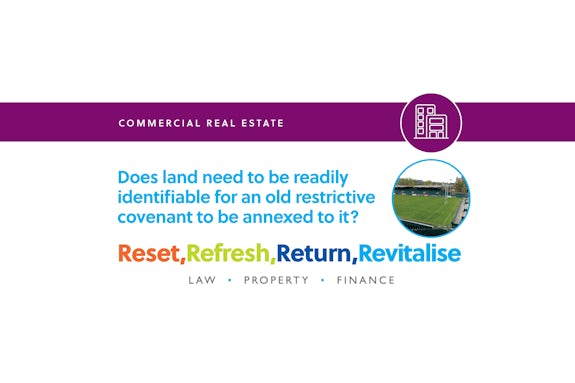By Gilson Gray
March 5, 2021

The recent case of Bath Rugby Ltd v Greenwood and Others is interesting because legal practitioners often come across titles with historic covenants and wonder about the practical implications of the same, and whether they are still relevant. In this case, the High Court found that a restrictive covenant that pre-dated the Law of Property Act 1925 (the “1925 Act”) had been annexed to the benefiting land, even though the exact extent of the benefiting land had become unclear over time.
The case concerned a restrictive covenant created in 1922, which could affect the redevelopment of a rugby ground. The claimant sought a declaration that the covenant is unenforceable on the basis that it is unclear what land it actually relates to.
The judgement confirmed that, although this covenant existed in equity only because the original covenantee had only an equitable interest in land, this had no effect on the covenant’s enforceability.
The High Court went on to find that there was nothing to indicate that the benefit of the covenant had been expressly assigned or that a building scheme existed. The covenant was therefore only enforceable if it had been annexed to benefiting land. The covenant pre-dated the deeming provisions of section 78 of the 1925 Act, which came into force on 1 January 1926. The court therefore had to consider if the words of the conveyance that created the covenant sufficed to annex its benefit to land owned by the original covenantee.
The court found that the conveyance’s wording did indeed indicate annexation, because the words referred to the covenant being for the benefit of the covenantee and “his successors in title”.
The court next had to consider whether the conveyance sufficiently identified the land that benefited from the covenant. The court’s judgement was that (for pre-1926 covenants at least) “it is sufficient for the conveyance to describe the land intended to be benefited in terms which enable it to be identified from other evidence”, and that it is not necessary to show that the benefiting land is “easily ascertainable”. This test applies when the covenant was created, and its validity is not affected by any subjective evidential difficulties in identifying the land later.
This covenant was still potentially enforceable because the benefiting land would have been identifiable at the time the covenant was created. The fact that the full extent of that land was now unknown did not prevent enforcement by someone who clearly owned land that benefited. The court therefore refused the claimant’s application.
The lesson that should be learnt from this case for all legal practitioners is that it is always good practice to identify clearly any land that is to benefit from a restrictive covenant. And it is always good practice where acting for the beneficiary of any such covenant to draft on the basis that its benefit stretches as wide as possible, so as not to get lost over the course of time. Conversely, to limit any unintended consequences, when acting for the covenantor it is essential to limit the benefit of any covenant to the land to which it is intended to apply.
If you would like further information on the topic discussed in this article, please contact Mark Sabey by email: msabey@gilsongray.co.uk or by phone: 0141 530 2029 / 07984 016 171 . You can also view Mark’s profile by clicking here.
The information and opinions contained in this blog are for information only. They are not intended to constitute advice and should not be relied upon or considered as a replacement for advice. Before acting on any of the information contained in this blog, please seek specific advice from Gilson Gray.

Murray combines a pragmatic approach with his breadth and depth of expertise to deliver the best commercial outcome for his clients.